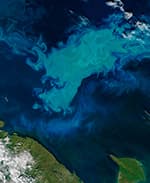- Polar flora and fauna
- > Short summers, extremely cold winters and vast amounts of ice and snow which reduce the food supply – the Arctic and Antarctic are among the regions most hostile to life on Earth. However, using an impressive range of adaptation strategies, plants and animals have managed to conquer even these areas and have formed globally unique biocoenoses. Yet in times of climate change their future has become highly uncertain.

Highly specialized and greatly threatened
Cold, light and ice determine the course of life in the Arctic and Antarctic. On land, these parameters are the reason that the growth or reproduction cycles for most organisms are very short, and that many animals leave the polar regions at the end of the summer. In the sea, the cold makes energy-efficient slowness essential, which in turn can make many organisms quite long-lived. The amount of sea ice, the food supply, and access to open water change in rhythm with the polar day and night.
Under the pressure of extreme environmental conditions, highly adapted biological communities with amazingly high biodiversities have developed in both polar regions, although the number of species does not begin to approach the dimensions of the tropical regions. In the Arctic, the greatest biological diversity is found on the land because of the relative distribution of the ocean and continents. In the Antarctic, on the other hand, almost all life is dependent on the sea. The degree of adaptation here and the number of endemic marine species are both significantly higher than in the Arctic. This is due to the geographic isolation of Antarctica and to its longer and more diverse glacial history.
The recurrent growth of Antarctic glaciers and ice shelves out to the continental margin has often brought the dwellers of the shelf seas to their physiological limits. Over time, this has resulted in the development of many new and highly specialized species, a process that scientists refer to as a species diversity pump. The inhabitants of the Arctic Ocean, on the other hand, were able to migrate to the North Pacific and North Atlantic in times of extensive icing. Today researchers can distinguish the Atlantic and Pacific sectors with regard to the marine ecosystems of the Arctic Ocean.
Plants overcome the cold and the shortage of light in various ways. These include cellular frost-protection mechanisms, a compact size, slow growth, heat-optimizing characteristics such as hairs or flower shapes, accumulation of large reserves, improved photosynthetic performance, largely asexual reproduction and multiple utilization of nutrients.
In endothermic animals, an insulating winter coat or plumage prevents the loss of valuable heat. They build large reserves of fat, warm each other when necessary, and survive extreme weather conditions in sheltered locations. Many ectothermic marine organisms utilize anti-frost proteins, move in energy-saving mode, grow slowly and produce comparatively few offspring, which they provide with the best possible conditions in early life.
But due to climate change, the physical foundations of life in the Arctic and Antarctic are shifting. Their polar ecosystems and highly specialized organisms face the imminent risk that they will not be able to adapt rapidly enough to survive. With the disappearance of sea ice, a habitat is vanishing that serves many species as a sanctuary, food source and hunting ground. These organisms are now threatened with extinction. Rising water temperatures are increasing the energy requirements for ectothermic organisms, while also paving the way for immigrant species. Food webs are becoming destabilized, and competition for food is intensifying. Acidification of the polar seas also makes survival more difficult for organisms that build calcareous shells or skeletons. Climate change thus poses a massive threat to the biodiversity and functionality of polar ecosystems.


